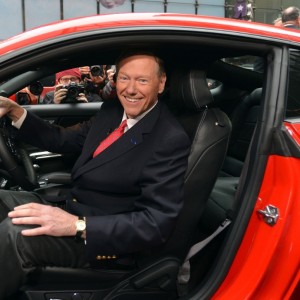On July 1, Alan Mulally will retire as CEO of Ford Motor Co. And when he cleans out his office in Dearborn, Mulally will leave behind him one of the most remarkable comeback stories in US industrial history.
The former Boeing executive took over Ford in 2006 and mortgaged it to the hilt, borrowing $23 billion. Doing so helped avoid bankruptcy and finance a company-wide overhaul. By late 2008, Ford’s stock was selling for as little as $1.39. But Mulally stuck to his knitting. In 2013, the company’s profits hit $7.2 billion and today, Ford stock sells for about $16 per share.
What was Mulally’s secret? There are many ways to explain his success, but in my view, Mulally turned Ford around by mimicking what made Henry Ford successful: he was ruthless in his pursuit of making his production methods and his products smaller, faster, lighter, denser, and cheaper. And the quintessence of that effort can be seen by looking at a single Ford product: the 1-liter, 3-cylinder, EcoBoost engine.
Before delving into the mechanics of that remarkable engine — which has been named the International Engine of the Year two years in a row — we need a bit of historical perspective as well as an understanding of a basic metric in physics: power density.
Henry Ford became an industrial titan because he brought mobility to the masses. He understood that his company’s success depended not on selling cars to the rich, but to everyone. That meant he had to produce low-cost, high-quality cars. And to do that he needed compact, light, low-cost engines that could efficiently convert energy into power.
He was also obsessed with speed. In 1904, Ford set a world speed record — 91.4 miles per hour — while driving a vehicle equipped with a massive 19-liter engine that produced about 70 horsepower. The volumetric power density of that engine (that is, the amount of energy flow) was about 2,760 watts for each liter of displacement.
By 1908, when Ford introduced the Model T, he had doubled the power density of his engines. The original Model T was equipped with a 2.9-liter engine that produced 22 horsepower, or about 5,660 watts per liter of displacement.
Over the following decades, Ford Motor Co.’s fortunes waxed and waned, but the company continued increasing the power density of its engines. The 1970 Ford Pinto used an engine that produced about 33,000 watts per liter of displacement, nearly six times as great as the engine in the original Model T.
Eight years ago, when Mulally took over, he slashed the number of models Ford offered, unified production lines, and made managers more accountable. He also focused on engines because in automobiles, the smaller, lighter, denser, and cheaper the engine, the better.
In 2009, Ford began marketing cars with engines bearing the EcoBoost label. EcoBoost engines use turbochargers, which increase power and efficiency by forcing more air into the combustion chamber. In 2011, it unveiled the 1-liter EcoBoost, which produces a whopping 123 horsepower, or nearly 92,000 watts per liter. That’s about 16 times as much power per liter of displacement as the Model T engine.
Perhaps even more remarkable is this: The power density of the 1-liter EcoBoost is roughly the same as that produced by the 8-liter, 16-cylinder, 1,001-horsepower engine found in the Bugatti Veyron, the fastest production car ever built. Want a Bugatti? It’ll cost you about $1.2 million. Or you can get an engine with Bugatti-like power density by buying a new Ford Fiesta for about 15 grand.
Bill Reinert, a recently retired Toyota engineer who helped develop the Prius, is an unabashed fan of both Mulally and the 1-liter engine. “He brought aircraft-building discipline to the auto industry,” says Reinert, who added, “Nobody in the auto industry has an engine that can compete with the 3-cylinder EcoBoost.”
Indeed, the 1-liter EcoBoost is an engineering masterwork. In most turbochargers, the impeller (the rotating device that compresses air) spins at 60,000 to 100,000 revolutions per minute. In the EcoBoost, it tops out at 248,000 rpm. The engine is light (97 kilograms) and is so small that the outline of its crankcase is about the same size as a sheet of office paper. Add in better fuel economy – Ford claims that a Fiesta equipped with the 1-liter engine gets more miles per gallon than any non-hybrid vehicle currently available in the US — and it becomes apparent why such a small engine is such a big deal.
During his eight years at Ford, Mulally reinvigorated a languishing company and turned it into one of the world’s most competitive automakers. In doing so, he saved it from bankruptcy, created jobs, and made money for shareholders. In a May 1 message to company employees, Ford’s executive chairman, Bill Ford, called Mulally a “Hall of Fame CEO.” Fortune recently named Mulally as one of the three greatest leaders in the world, behind only Angela Merkel and Pope Francis.
And a key part of Mulally’s legacy is a hall-of-fame engine designed for the mass market that has set new benchmarks for power density and efficiency.
You can purchase a copy of Robert Bryce’s new book here: Smaller Faster Lighter Denser Cheaper: How Innovation Keeps Proving the Catastrophists Wrong

